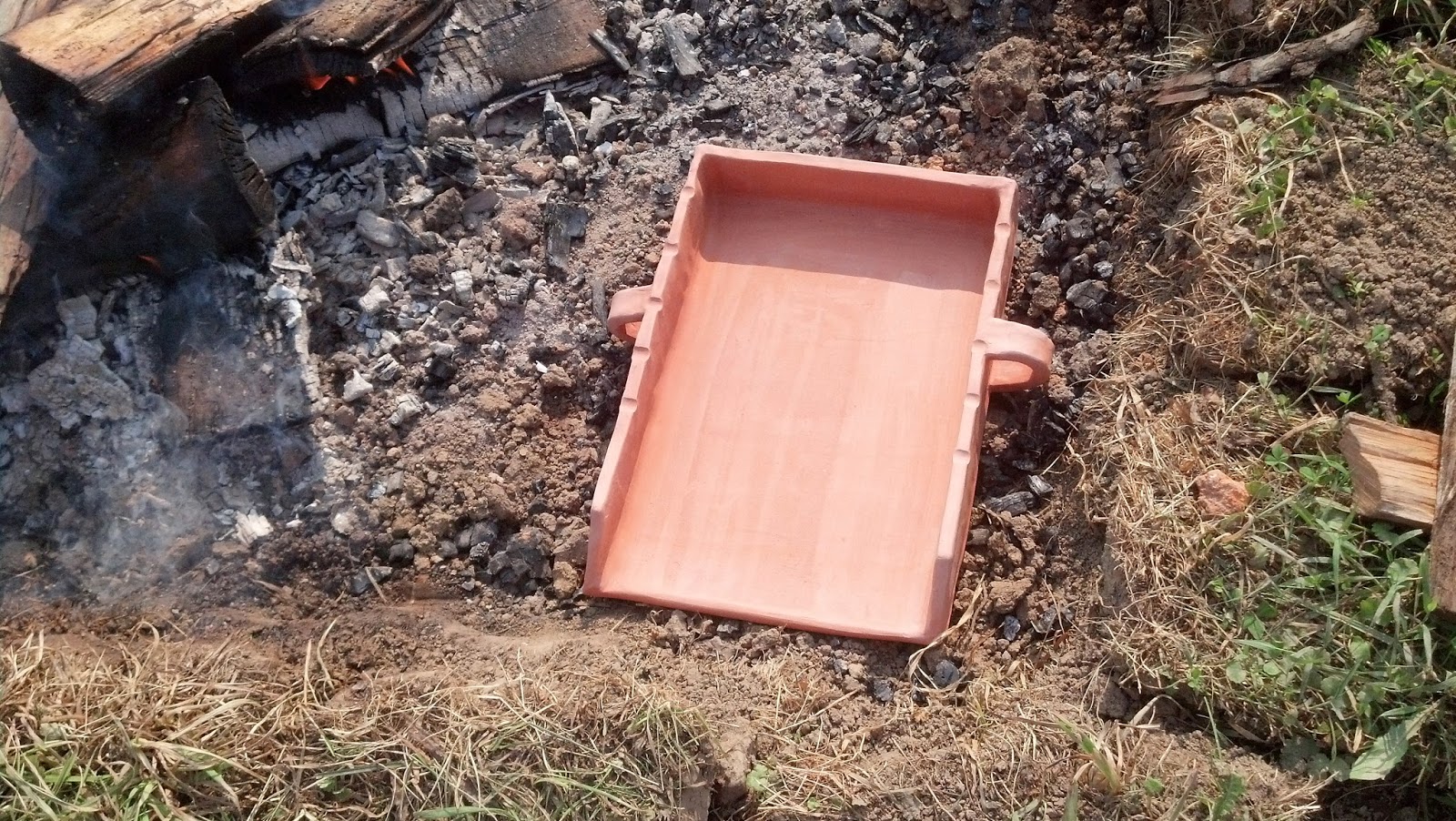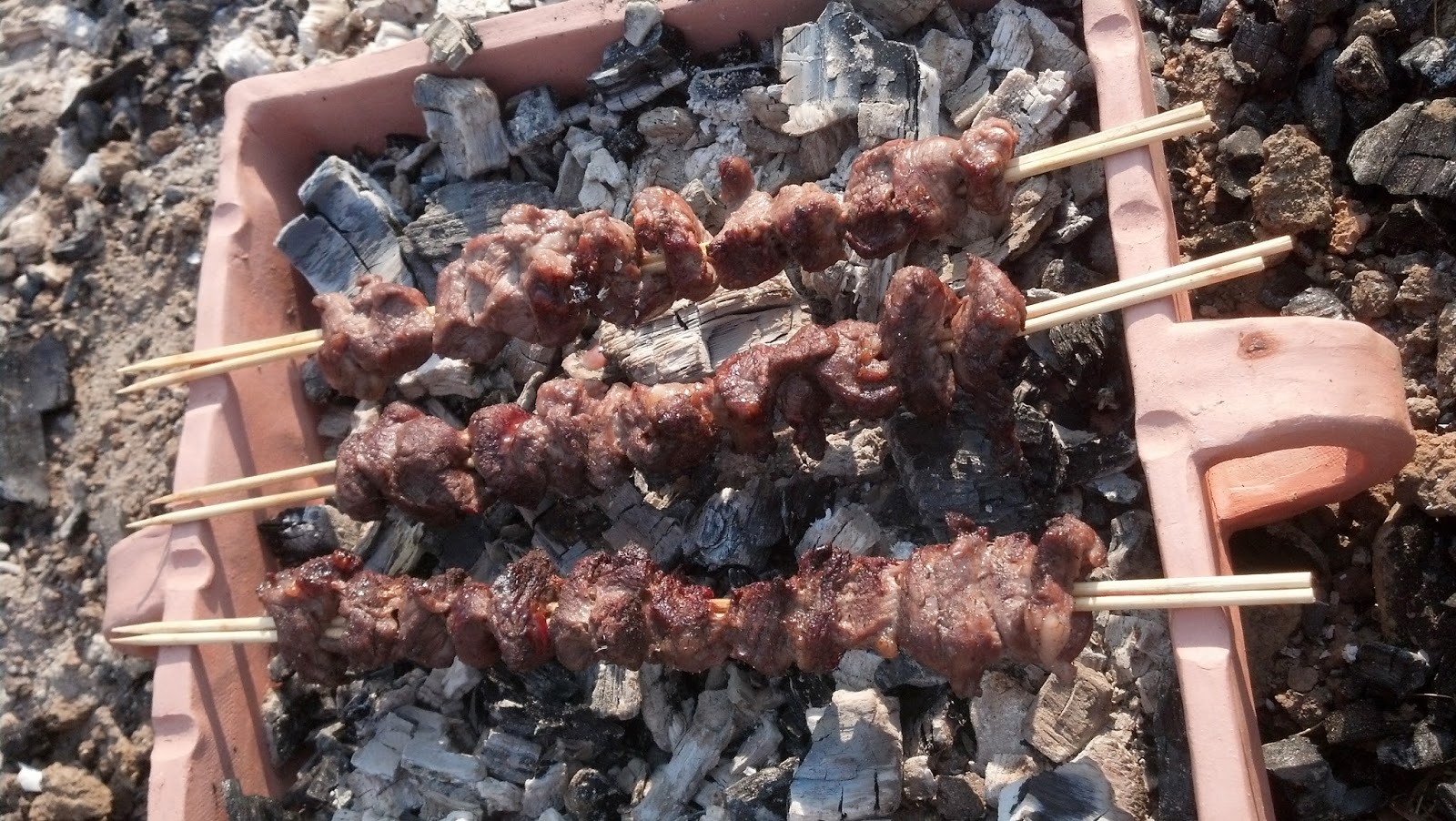Last week when perusing the merchants at the
Pennsic War,
I came upon a potter, Anne L. Carenbauer of Nonna's Mugs and Jugs, who had made a reproduction of a Mycenaean cooking
tray of a type archaeologists speculate was used for cooking the
ancient versions of souvlaki or kebabs.
I've been interested in finding one to experiment with for a while and
asked her the price. She replied that she had made a second one which
had cracked when she used it, so she was uncomfortable selling it to me,
but that I was welcome to borrow it and try using it if I would report
back to her the results. I scuttled back to camp clutching my prize....
 |
| The tray prepared and ready to go. |
I am experienced with open fire
cookery in clay so I soaked the tray for about a half hour as I would with other crockery, prior to
warming it slowly by the fire. I had
previously started a good fire which steadily produced coals throughout
the cooking time. I made a flat place in the fire pit for it to sit,
however in retrospect I might have been better off having it out on the
grass beside the pit, as it would have been subjected to less heat from
the coal making process. We had gotten some chicken and beef for the
communal dinner that night but I also bought some lamb for a first round
of experimentation before the main event, just in case there was a
terrible failure. FYI Pennsic shoppers, the lamb came from the Cooper's store and was from a local farm.
 |
| The meat on one bowing skewer. |
To
prepare the lamb, I cut it up into small pieces, no more that an inch
square, and marinated it in a mixture of cider vinegar, red wine, salt
and pepper for about a half hour. Then I put the morsels on bamboo skewers and
shoveled coals into the tray. The first thing I discovered after I had
put them on was that one skewer is not strong enough to support all that
meat so I immediately pulled them off and inserted an additional
one. Having two skewers also created stability so that the skewer of
meat did not turn when it was placed over the coals. The meat cooked
faster than I had expected. Although I didn't time it, I would
guesstimate that it cooked in about 10 minutes. It was crispy but not
burned and had a pleasant, slightly smoky flavor.
 |
| A skewer of cooked lamb. |
 |
| Aren't you hungry? |
The
cooking continued until the lamb was all done and then I turned my
attentions to the beef, which I prepared in the same manner.
Between meats, I stirred the coals around and with a blowpipe blew out
the ash (there wasn't very much), then I added more coals from the
feeder fire. The beef cooked well, but part way through I heard the
telltale 'pink' of cracking redware, then as I cooked a large crack
opened up on the left side of the tray. I finished the beef and again
cleaned out the tray and added more coals to cook the chicken. This gave
me a chance to see what was going on, and as it turned out, the crack
did not go all the way across the tray. The chicken was cooked and the
meat enjoyed by all the diners.
Feedback
In
Minoans and Mycenaeans: Flavours of Their Time by Yannis Tzedakis and Holley
Martlew, the authors make the point that these trays were made of
unfired ceramic which presumably would fire a certain amount as they
were used. I don't know if that would give them more 'flexibility' but
it would be interesting to try cooking in an unfired tray. Alternatively, the trays could have simply been used until it became unusable and discarded for a new one. Even if the end had broken completely off this tray, I could have cooked four skewers of meat without a problem.
Besides the book mentioned above, interested readers should seek out the work of Dr. Julie Hruby of Dartmouth College. She has written extensively on Mycenaean foodways and performed cooking experiments with reproduction cookware. You can find an article of her's online here, and I would direct your attention to her discussion of souvlaki trays on p. 154. She was featured in the Valley News in June and on NPR.
 |
| Note the size of the crack. |
|
Trays
need to have high enough sides to accommodate both the coals and the
meat. The sides on this tray were about a centimeter too low and the
meat ended up resting directly on the coals. It didn't burn it but you
had to pick the hot coals off when you removed the meat.
I
think what happened with the cracking was the front of the tray flexed
downwards as it became hotter. When it was cooking and at its hottest,
the gap at the crack was at least a millimeter but after it had cooked
the ceramic returned to its previous position.
Other
ceramic cookware which I have used for open fire cookery has had a clay
body quite high in grog. This seems to help with thermal issues and might also
make the piece somewhat more flexible. Its something to consider for
future trays.
I had a lot of fun cooking in this tray and am grateful for the chance to experiment with it. I'm very interested in trying an unfired tray to see what differences there might be, if any, in the behavior of the ceramic. Below are the rest of the photos we took that afternoon.
 |
| Ready to receive meat! |
 |
| After a second skewer as added. |
 |
| More lamb on the coals. |
 |
| Raking the coals with a stick. |
 |
| Blowing the coals with the blowpipe. |
 |
| Lamb cooking. |
 |
| Note how crispy it is on the edges. |
 |
| Yum! |
 |
| Cut up beef. It should be small. |
 |
| Cooked beef. |
 |
| Preparing to add chicken, note the crack. |
 |
| Coals added for the chicken. |
 |
| Chicken on the coals. |
 |
| Chicken after a few minutes. |
 |
| Detail of the crack. |
 |
| Overall view of the tray. |





















No comments:
Post a Comment